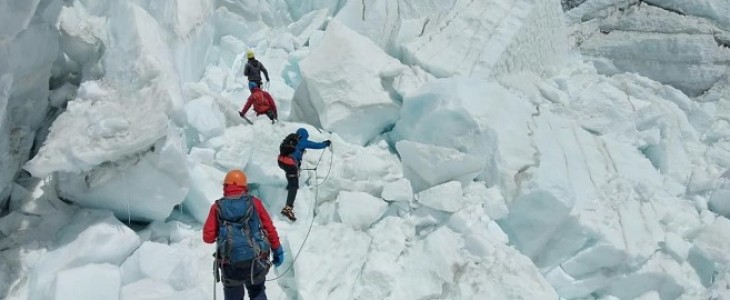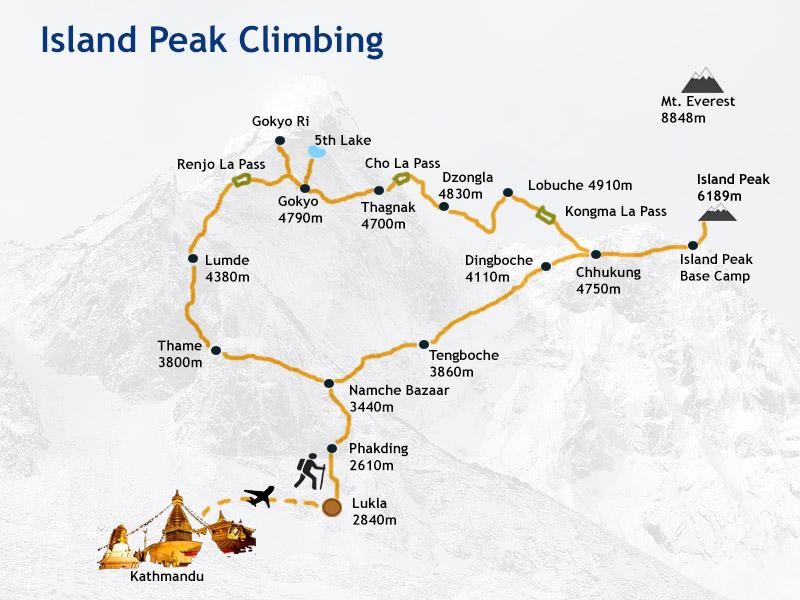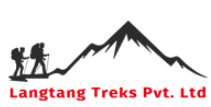Locate Us !
z-street, Thamel, post box no:19233
Island Peak Climbing from Chukkung
Trip Overview
For trekkers already exploring the Everest Base Camp or Chhukung Valley, our Island Peak Climbing from Chhukung package offers a focused and fully supported expedition to one of Nepal’s most popular trekking peaks — Island Peak (6,189m), locally known as Imja Tse.
Starting from Chhukung (4,730m), this short yet thrilling climbing adventure is designed for those who wish to experience the excitement of Himalayan mountaineering without committing to a long expedition. From Chhukung, the route follows the beautiful Imja Valley, leading to Island Peak Base Camp (5,200m), where climbers receive thorough training and a detailed climbing briefing from our certified Sherpa guides.
The summit climb begins before dawn, ascending through rocky ridges and glacial sections with fixed ropes for safety. The final push to the summit ridge rewards you with an unforgettable panorama of Lhotse, Nuptse, Ama Dablam, Makalu, Baruntse, and the majestic Everest towering above all. The feeling of standing atop Island Peak — surrounded by the Himalayas — is truly unmatched.
Ideal for trekkers with previous high-altitude experience or those who have completed the Everest Base Camp trek, this climb offers the perfect combination of technical challenge, scenic beauty, and mountaineering achievement in just a few days.
With professional climbing support, high-quality equipment, and carefully planned acclimatization, our Island Peak Climb from Chhukung ensures a safe, rewarding, and unforgettable Himalayan experience.
Highlights of the Chukkung Route
-
Efficient Itinerary: Ideal for trekkers already acclimatized in the Everest region.
-
Close-up Summit Experience: No long detours—straight from the valley to the peak and back.
-
Stunning Landscape: Views of the Imja Glacier, Amphu Laptsa Pass, and snow-draped Himalayan giants.
-
Adventure & Challenge: A blend of trekking and technical climbing, including rope ascents, crampon use, and ice axe handling.
Detail Itinerary Expand All
Day 1: Meet our guide at Chukkung | Trek to Island Peak Base Camp (5,100m) and training
Trek for 3–4 hours along rugged moraines and glacial streams.
Reach the base camp, set up tents, and attend a pre-climb briefing from climbing guides.
Spend the afternoon preparing equipment and practicing basic rope and ice techniques.
Day 2: Summit Island Peak (6,189m) – Return to Base Camp or Chukkung
Start the climb early, usually around midnight.
The route begins with a steep, rocky trail that leads to the glacier. Roped-up glacier travel follows, including crevasse crossings and a headwall climb (with an inclination of around 60–70°) using fixed ropes.
The final ridge leads to the summit, where panoramic views of Everest, Lhotse, Nuptse, Ama Dablam, Makalu, and Baruntse reward the effort.
After celebrations, descend carefully back to Base Camp.
Day 3: Contingency Day
Customize Itinerary
What's Included?
- Accommodation during Climb: Tented accommodation during the climb
- Meals: Full board meals during camping days
- Guide: Nepal Mountaineering Association-certified and English-speaking climbing guide and assistant guide as per the group size.
- Permit: Island Peak Climbing Permit
- Souvenir: Duffle Bag, Trekking T-shirt
- Garbage deposit fee
- Food, accommodation, insurance, equipment, and medicine for all staff.
- Exclusive medical kit bag carried by the guide
- All our government taxes, VAT, tourist service charges.
- Official expenses
What's Not Included ?
- Your personal expenses for mineral water, soft beverages, confectionaries, laundries, phone calls, hot drinking water, bbar bills showers etc.
- Internet facility, battery chargers, multi plugs etc.
- Extra baggage excess while flying to Lukla.
- Medical expenses and trip cancellation.
- Any other extended trips and accommodation.
- Tips of ga guides, porters and driver as a token of appreciation.
- Any other expenses or charges that are not mentioned in “cost includes” list.
- Nepal arrival visa
Useful Information
PASSPORT AND VISA:
All the foreign nationals (except Indian nationals) are required to display Visa while entering Nepal. Nepalese Visa can be obtained either at the Nepalese Embassy of the respective country or can be obtained during your arrival at the International Airport in Kathmandu or from Nepal’s border entry point in Kakadvitta, Birgunj, Bhairahawa, Nepalgunj, Gaddachowki on the Nepal-India border and Kodari on the Nepal-China border.
Certain nationals are requested to arrange Visa prior to arrival in Nepal. The listed countries are- Afghanistan, Iraq, Cameroon, Ghana, Somalia, Swaziland, Palestine, Zimbabwe, Nigeria, Ethiopia and Liberia and cannot secure Nepalese Visa on arrival.
VISA FACILITY DURATION FEES
Multiple Entry 15 Days US$ 30 or equivalent convertible currency
Multiple Entry 30 Days US$ 50 or equivalent convertible currency
Multiple Entry 90 Days US$ 125 or equivalent convertible currency
You can also download the VISA form and fill it up. Please go through the link as below: http://www.online.nepalimmigration.gov.np/tourist-visa
MONEY & CREDIT CARD INFO
Most of the credit card, master and visa card is blocked from your card provider. It may be because of a security reason. It, sometimes, may bring you in a problematic situation that you can't get money from ATMs. To find yourself free from this problem, you can call your card provider before you travel to Nepal and inform there that you are traveling to Nepal. Ensure them to give the authorization for the payment. In Nepal, 3.5 % service charge is applicable as per Nepal Bank rules, on top of your payable amount for the trek cost. So, we suggest you bring some cash in USD just in case your card doesn’t work. Likewise, be sure you have brought some small amount for your daily expenses as well as for those items which are not included in our cost. If you want to exchange money, we provide you with the facility to change your money. Or, you can take help from Money Changers in Thamel.
TRAVEL INSURANCE:
While traveling to Nepal, you are requested to have travel insurance that should cover any comprehensive expenses possible to acquire due to medical issues or accidents. Especially, your travel insurance must protect air ambulance, treatment charges, rescue and evacuation, product cancellation and refundable charges, flight delay, and cancellations.
Insurance Policy:
Traveling in the Himalayas is full of adventurous; hence it is wise to choose a proper insurance policy. While choosing your insurance policy, make sure that it will protect all such unforeseen expenses. You must ensure that the policy you do take provides an adequate level of protection, well familiar with your itinerary and covers you for the activities involved. You must carry proof of insurance (e.g. your insurance certificate) with you on the holiday or send us a scanned copy and it must be issued from your homeland.
RECOMMENDATION:
World Nomads
https://www.worldnomads.com/
NOTE:
Please, kindly note, this given reference of the insurance company above is only a recommendation, which based on the recommendation of our previous travelers who have used them for their Treks Planner Nepal holidays. You could review their update insurance policy by contacting them directly.
VACCINATION FOR NEPAL
Travelers should consult with their physician or update on vaccination requirements before travel. (Your doctor or the health-care provider will determine what you will need, depending on factors such as your health and immunization history, areas of the country you will be visiting, and planned activities). For traveling to Nepal, we recommend you to take vaccination of Polio, Tetanus, Typhoid, Hepatitis A, Hepatitis B, Rabies, etc. However, it is not mandatory but recommended.
ALTITUDE SICKNESS (ACUTE MOUNTAIN SICKNESS)
Altitude sickness, also known as AMS (acute mountain sickness), is caused by a lack of oxygen at high altitudes (normally above 3,000m). It occurs as the result of our bodies’ inability to adapt to a sudden increase in altitude. If given time, our bodies will adjust and a gradual ascent will decrease the possibility of altitude sickness.
PREVENTION OF AMS: Go slowly, drink a lot of water, and pay attention to the sensations of your body. If symptoms occur you have climbed too far for the day. Rest at the same altitude will give you time to acclimatize and usually relieve mild symptoms.
MILD SYMPTOMS: Headache, nausea, loss of appetite, and mild shortness of breath with minimal exertion, difficulty sleeping, dizziness or lightheadedness, mild weakness, fatigue, a general unwell feeling.
SERIOUS SYMPTOMS: The inability to recover from shortness of breath with rest, severe persistent headache, low urine output, vomiting, confusion, delirium, loss of coordination. These require immediate descent as acclimatization will not take place at the same altitude.
The key is to trek slowly, carry a light pack and just take it easy. Allow your body the time it needs to acclimatize.
ARRIVAL INSTRUCTION
Upon your arrival at TIA International Airport, our company's representatives are stationed to pick you up. They will be holding your name sign along with the company's name in it. Our office representative will escort you to your hotel in Kathmandu.
Route Map

Departure dates and price
The given cost are per person and exclude international flights. Given below are the departure dates available for online booking. If the given date is not favorable then please contact us and we will happily customize your trip on dates more appropriate for you.
Note: If your group size is of more than 1 pax then you can set your own departure date.
| Start Date | Trip Price | Discount | Discounted Price | Action |
|---|
Clients Reviews

Robert
2024-10-15
Climbing Island Peak (Imja Tse) from Chukkung
Climbing Island Peak (Imja Tse) from Chukkung was an unforgettable adventure. Starting from Chukkung made the approach smooth and allowed for excellent acclimatization while enjoying spectacular views of Everest, Lhotse, and Ama Dablam. The summit climb was challenging yet achievable, with the guides providing expert support and ensuring safety every step of the way. The experience was thrilling and rewarding. Langtang Treks is highly recommended!!
USD895pp
99% Based on 56 reviews
Duration : 2 Night 3 Days
- This trip is fully customizable
- Have a big group ? We can help.
- We can help you make it fit your budget.
- You can schedule your own departure dates
